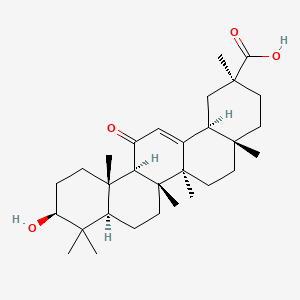| Authors | Title | Published | Journal | PubMed Link |
|---|---|---|---|---|
| White R and Hiley CR | Hyperpolarisation of rat mesenteric endothelial cells by ATP-sensitive K(+) channel openers. | 2000 | Eur. J. Pharmacol. | pmid:10844125 |
| Kalaiarasi P et al. | Hypolipidemic activity of 18beta-glycyrrhetinic acid on streptozotocin-induced diabetic rats. | 2009 | Eur. J. Pharmacol. | pmid:19361497 |
| Clarke TC et al. | ATP release by cardiac myocytes in a simulated ischaemia model: inhibition by a connexin mimetic and enhancement by an antiarrhythmic peptide. | 2009 | Eur. J. Pharmacol. | pmid:19101539 |
| Matsumoto T et al. | The anti-ulcer agent, irsogladine, increases insulin secretion by MIN6 cells. | 2012 | Eur. J. Pharmacol. | pmid:22542662 |
| Lee CS et al. | 18β-Glycyrrhetinic acid potentiates apoptotic effect of trichostatin A on human epithelial ovarian carcinoma cell lines. | 2010 | Eur. J. Pharmacol. | pmid:20868669 |
| Ishida T et al. | Effect of 18β-glycyrrhetinic acid and hydroxypropyl γcyclodextrin complex on indomethacin-induced small intestinal injury in mice. | 2013 | Eur. J. Pharmacol. | pmid:23792039 |
| Nomura R et al. | Bee venom phospholipase A2-induced phasic contractions in mouse rectum: independent roles of eicosanoid and gap junction proteins and their loss in experimental colitis. | 2013 | Eur. J. Pharmacol. | pmid:24012929 |
| Kawakami Z et al. | Glycyrrhizin and its metabolite 18 beta-glycyrrhetinic acid in glycyrrhiza, a constituent herb of yokukansan, ameliorate thiamine deficiency-induced dysfunction of glutamate transport in cultured rat cortical astrocytes. | 2010 | Eur. J. Pharmacol. | pmid:19818347 |
| Shamekh R et al. | The role of connexins in the differentiation of NT2 cells in Sertoli-NT2 cell tissue constructs grown in the rotating wall bioreactor. | 2006 | Exp Brain Res | pmid:16328273 |
| Sung YJ et al. | Intercellular calcium waves mediate preferential cell growth toward the wound edge in polarized hepatic cells. | 2003 | Exp. Cell Res. | pmid:12837277 |
18alpha-glycyrrhetinic acid
18alpha-glycyrrhetinic acid is a lipid of Prenol Lipids (PR) class. 18alpha-glycyrrhetinic acid is associated with abnormalities such as Wiskott-Aldrich Syndrome. The involved functions are known as inhibitors, salivary gland development and branching morphogenesis.
Cross Reference
Introduction
To understand associated biological information of 18alpha-glycyrrhetinic acid, we collected biological information of abnormalities, associated pathways, cellular/molecular locations, biological functions, related genes/proteins, lipids and common seen animal/experimental models with organized paragraphs from literatures.
What diseases are associated with 18alpha-glycyrrhetinic acid?
18alpha-glycyrrhetinic acid is suspected in and other diseases in descending order of the highest number of associated sentences.
Related references are mostly published in these journals:
| Disease | Cross reference | Weighted score | Related literature |
|---|
No disease MeSH terms mapped to the current reference collection.
PubChem Associated disorders and diseases
What pathways are associated with 18alpha-glycyrrhetinic acid
There are no associated biomedical information in the current reference collection.
PubChem Biomolecular Interactions and Pathways
Link to PubChem Biomolecular Interactions and PathwaysWhat cellular locations are associated with 18alpha-glycyrrhetinic acid?
There are no associated biomedical information in the current reference collection.
What functions are associated with 18alpha-glycyrrhetinic acid?
Related references are published most in these journals:
| Function | Cross reference | Weighted score | Related literatures |
|---|
What lipids are associated with 18alpha-glycyrrhetinic acid?
There are no associated biomedical information in the current reference collection.
What genes are associated with 18alpha-glycyrrhetinic acid?
There are no associated biomedical information in the current reference collection.
What common seen animal models are associated with 18alpha-glycyrrhetinic acid?
There are no associated biomedical information in the current reference collection.
